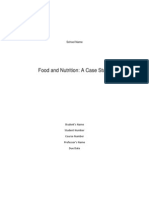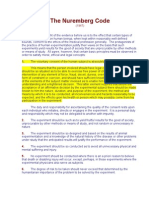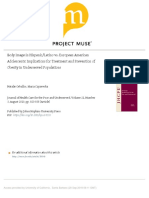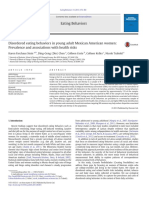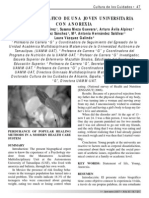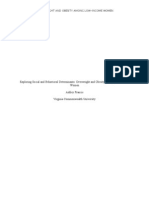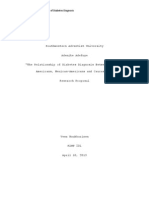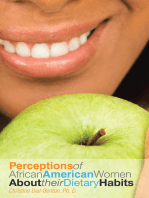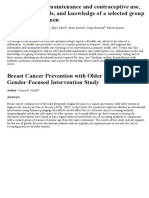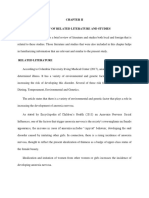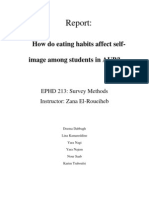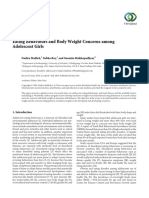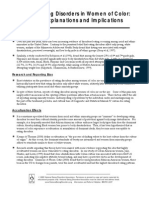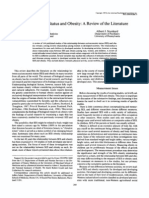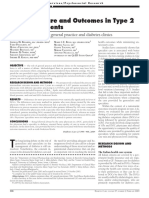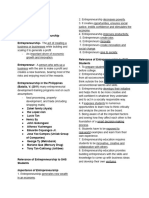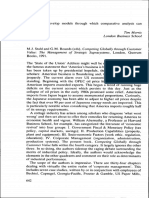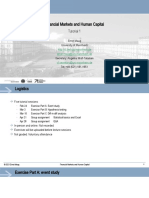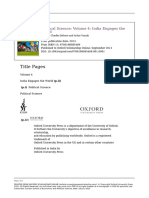SOCL365 Final
SOCL365 Final
Uploaded by
CDKalbleCopyright:
Available Formats
SOCL365 Final
SOCL365 Final
Uploaded by
CDKalbleOriginal Title
Copyright
Available Formats
Share this document
Did you find this document useful?
Is this content inappropriate?
Copyright:
Available Formats
SOCL365 Final
SOCL365 Final
Uploaded by
CDKalbleCopyright:
Available Formats
AComparativeReviewofResearchonDisorderedEatingAmong CollegeWomenintheUnitedStatesandUnitedKingdom ConnieKalble SOCL36502W LoyolaUniversityChicago Dr.
Krogh 30April2012
Kalble
Background WomeninWesternizedsocietiesfeelconstantpressuretobeincreasinglythin.The ratesofbothbodyandeatingpathologyinwomenareatanalltimehigh,especiallyamong college women, a very vulnerable population. In the past fifteen years, researchers in the UnitedStatesandtheUnitedKingdom,twohighlyWesternizedcountries,haveextensively studied the risk and resilience predictive factors for eating pathology. The UK has implementedmanylawstoregulatethepresenceofunrealisticidealsinthemedia,yetthe ratesofdisorderedeatingremainverysimilarintheUSandUK. Purpose&Method This study looks at the most common predictive factors studied by researchers in the United States and United Kingdom over the past fifteen years. A content analysis of twelve randomly selected scholarly articles from the US and UK was conducted and each wascodedforthesignificanceoftheindependentvariablesinpredictingdisorderedeating behaviorincollegewomen. Results&Implications Results indicated that there was not one independent variable that was used significantlymorethanothersacrossallstudiesexamined.Crosstabulationrevealedthat the most significant differences between studies in the United States and the United Kingdom were in terms of the increased prevalence of selfobjectification in US studies comparedtoUKstudies.BodyshameandsurveillancehadanequalpresenceintheUSand UKstudies.WhiletheconsumptionofmediawasnearlyequallyrepresentedacrossUSand UK studies, it had a very small presence in the studies. Many times media consumption leadstofactorssuchasbodydissatisfaction,selfobjectification,lowlevelsofselfesteem, and body shame. This study reveals the need for an increase in media studies, especially the impact of media of womens body and eating pathology.
Kalble
TableofContents Section PageNumber 4 4 8
Introduction LiteratureReview Design Data Methods
8 9 10 11 13 14 14 17
TheRealImpactofMedia Results
ImprovementstoStudy Conclusion
Bibliography Appendices
Kalble
Introduction Many young women in Westernized societies struggle with issues such as body dissatisfaction and disordered eating behavior. Researchers have made great efforts to identify the lead risk and resilience factors for young women in the development of disordered eating behaviors and attitudes. The national literature regarding womens eating and body pathology in the US and UK is fairly extensive. The levels of body dissatisfaction and disordered eating in the US have been on the rise, with no one direct cause identified. On the other hand, disordered eating in the United Kingdom has been shown to be linked to external influences, not an issue of individual dissatisfaction. Consequently, the United Kingdom has implemented many programs to regulate the perpetuation of the thin ideal in the media, whereas the United States has no such programscurrentlyinplace,yetthelevelsofdisorderedeatinginthesecountriesarevery similar.AcrossculturalstudyofthesetwoWesternizedcountrieshasyettobeconducted. Thisstudywillhighlighttheeffects,orlackthereof,ofpoliciesimplementedinWesternized countries on young women living in these environments. This study bridges the gap currently present in the scholarly literature on body and eating pathology of college womenintheUnitedStatesandUnitedKingdom. LiteratureReview WomenintheUnitedStatesarestrugglingwitheatingpathologyinrecordnumbers. 6%ofyoungwomenareestimatedtohavesubclinicallevelsofdisorderedeating(Bishop, Bauer, & Baker, 1998). Whereas, 0.3% of young women are estimated to have a clinical diagnosisofAnorexiaNervosa,and1%ofthispopulationisestimatedforBulimiaNervosa
Kalble
(Berkman,Lohr,Bulik,2007).RatesofdisorderedeatingintheUnitedKingdomhavebeen shownintheliteraturetobeveryequivalenttothosepresentintheUnitedStates(Makino, Tsuboi,Dennerstein,2004). Womenhavebothindividualandcollectiveexperiencesthatshapetheirselvesand individual personas. Personality traits such as perfectionism are generally seen in the literature as common predictors of disordered eating behaviors. Family backgrounds, includingahistoryofsexualabuseandacontrollinghousehold,havealsobeencommonly showntopredicteatingdisorders.FamilialinfluenceinboththeUnitedStatesandUnited Kingdom has been shown to significantly affect womens standards of beauty, primarily thinness,fromaveryearlyage(Fairburn,Brownell,2002).Manywomenresorttohostility towardstheirfamilyandcompulsivebehaviorstocopewiththeseissues(Berkman,Lohr, Bulik,2007).However,environmentalfactorsandsocioculturalinfluenceshavegenerally been blamed for the development of body and eating pathology (Fredrickson & Roberts, 1997). This is thought to be because of the Westernized norms of beauty and the ideals aspiredbythesewomen. Women are constantly bombarded with images of the thin ideal in the media. The majority of women have many deeplying anxieties about not being thin enough. These media influences inform women of their right to starve, and the progression of technology allows women to share their thinspirational quotes and images, mostly of celebrities in the media (Saukko, 2006). This phenomenon is nothing new. Since the beginning of the 1920s, women in the United States have engaged in body surveillance, monitoringthewayothersseetheirbodyandtakinganoutsiderperspectivetoselfimage. However, this was initially an upper class issue. Beginning in the 1960s, this experience
Kalble
became more prevalent, mirroring the advent of television and the wide range of media (Nasseretal.,2005). Selfobjectification is common among women in Westernized countries, perpetuated by the gendered norms that have been in place there for centuries. Women havebeentaughtbothbythemediaandfamilyhowtoproperlygroomandmanicuretheir bodies until they are perfect. Fat talk, or the discussion of the flaws women perceive themselvestohave,hasbecomeverycommonplaceinWesternizedsocieties,somuchsoit is considered a social norm, especially among friend groups. This norm is largely problematic because it leads women to compare themselves to one another, which is largelyassociatedwithbodydissatisfaction(Payneetal.,2011). TherateofobesityisatacurrenthighintheUnitedStates,whereasthemodelsare youngerandthinnerthantheyhaveeverbeen.Whilethemediaispartlytoblameforthe glamorizationofcelebritiesopenwiththeirexperienceswitheatingdisorders,themedical industry is also to blame. Medical science has allowed women to change their physical appearances in an infinite number of ways, from the use of weight loss formulas to the everyday nature of plastic surgery. Due to the progression of technology, Photoshop and plastic surgery have significantly influenced the way society sees the womans body (Nasseretal.,2005). Inordertocopewiththeunrealisticbodyfocusedstandardssetforthembysociety, women engage in practices such as body watching and food monitoring. Women spend hours in front of the mirror carefully examining physical changes from day to day, evaluatingtheresultsoftheirruthlessefforts.Thisillustrateshowwomenseethemselves from an outsiders perspective, viewing their bodies as objects. The standards for these
Kalble
womenarelargelydepictedbythemedia,consistingofmodels,ballerinas,andgymnasts. Womenthataregreatlyaffectedbythebodyperfectexampleperpetuatedbythemediause theirclothing,photographs,and,mostfrequently,ascaleinordertotracktheireffortsin achieving the thin ideal. Since many times women cannot achieve the high beauty standardssetbysociety,theyturntodisorderedeastingbehaviors,especiallyatsubclinical levels,toloseweight(HesseBiber,1996). Almost seventy percent of young women reported being influenced by fashion magazines to achieve the perfect body and almost fifty percent expressed desire to lose weightduetothosesameimages.Manysignificantrelationshipshavebeenshownbetween themediaandunhealthypracticesandlifestylechoicesamongwomen.Thereisapositive correlation between the amount of fashion magazines read by young women and dieting behaviors over time. The most shocking of these statistics is the positive relationship betweentheeffortwomenreportedputtingintolookinglikeimagesinthemediaandthe likelihoodshewouldbeginpurgingoverthenextyear(Field,2000). The media has also been criticized for the sexual objectification of women. Seeing theobjectificationofwomeninthemediahasbeenshowntohavesignificanteffectsonthe selfobjectificationofyoungwomen.Whenyoungwomenseehypersexualizedmedia,they areatahigherriskfordevelopinglowselfesteemandhigherlevelsofbodyshame.Dueto their diminished ability to cope properly with such images, women turn inwards and attempttoconformthemselvestothebodyperfectstandardssetforthbythemedia.The bodybecomesapawnofsortsfortheindividual,meaninglesstothemthantheyperceiveit to mean to others. The sexual objectification of women is also seen as a significant risk
Kalble
factor in the development of disordered eating attitudes and behaviors among women (Calogero&Thompson,2008). The literature examining body and eating pathology names college as the most vulnerabletimeforwomentodevelopthesedisorders(Keel&Klump,2003).Womenare exposedtomanynewexperiencesandchangesatthispointintheirlivesincludingmoving awayfromhome,theinfluenceofnewfriendgroups,anewlivingenvironment,andmedia consumption,manyofwhichforcewomentocopedifferently,andoftenmaladaptively. Design TobestreviewthecurrentstateofresearchoneatingdisordersbothintheUnited States as well as the United Kingdom, this study utilized a content analysis of scholarly journal articles. This approach was chosen to frame the risk and resilience factors for eatingpathologyincollegewomenintheUnitedStatesandUnitedKingdomoverthepast fifteen years. A surveybased study would have been preferred, but a sample of college womenfromtheUnitedKingdomcouldnotbeobtained.Thispaperwillexaminethemain contributorsresearchershavenamedasprimaryriskandprotectivefactorsfordisordered eatingincollegewomen.TheUnitedKingdomhasimplementedmanyprogramstoregulate the perpetuation of the thinideal in the media, whereas the United States has no such programscurrentlyinplace,yetthelevelsofdisorderedeatinginthesecountriesremain verysimilar. Data
Kalble
Sixtyfive scholarly journal articles were collected, which have been published
withinthepastfifteenyearsandexaminetheriskandresiliencefactorsofeatingpathology. Since the literature on eating pathology is so large, the focus of this study is on college womenandthefactorsthatmostaffectthispopulation.Articlescamefrombothnational and international journals, including Body Image, Eating Disorder Review, Sex Roles, Psychology of Women Quarterly, Journal of Womens Health, British Journal of Health Psychology, International Journal of Eating Disorders, British Journal of Psychiatry, and EuropeanEatingDisordersReview.Articlesthathavebeendeemedproperforinclusionin this study have been published between 1995 and the present that evaluates risk and resiliencefactorsfordisorderedeatinginyoungadultwomen.Thesearticleswereentered into a database and randomly assigned a number. Using a random number generator, a sample of these articles was chosen, six articles evaluating a US population and six evaluating a UK population. The twelve randomly selected articles are considered representative of the population of articles published on eating pathology in the United StatesandUnitedKingdomoverthepastfifteenyears. Methods All twelve articles randomly selected for inclusion in this study were coded according to significance in predicting disordered eating behavior on a code sheet listing independent variables collected from the scholarly articles (see Appendix 1). The code sheets were then entered into SPSS data analysis software. From those code sheets, the variables that most often predicted disordered eating behavior as well as variables that were most often included in studies but did not predict disordered eating behavior were
Kalble 10
analyzed.CrosstabswererunonthedataenteredintoSPSStoseerelationshipsbetween predictorsofeatingpathologyandtheoriginofparticipantsinpublishedstudies. TheRealImpactofMedia Bodydissatisfactionstemsfromthefeelingsparticipantshavetowardsthephysical
componentsoftheirbodies.Measuresusedtogaugebodydissatisfactionaskparticipants toratetheirlevelofagreementtostatementslikeIthinkmythighsaretoolargeorIlike the shape of my buttocks. While it may be that participants are dissatisfied with their physical appearance in and of itself, it is more likely that participants are engaging in a form of social comparison. This may be a comparison among peers and family members, but it may also be a comparison of ones self to the medias representations of women, whichisgenerallyhypersexualizedandincreasinglythin. Similartobodydissatisfaction,bodyshameisexperiencedwhenrespondentshave
feelings of shame and humiliation in not conforming to a norm or ideal. This shame commonlyarisesinwomenwhenthereisagapbetweentheperceptionsoftheselfdiffer fromtheculturallyacceptedandinternalizednormsofbeauty.This, too, is a reflection of thepervasivemessagesandnormsthemediasetsforthforwomenasanideal.Participants whoreportedengaginginbodysurveillanceactivelyviewedtheirbodyfromanoutsiders perspective. Body surveillance is a highly dangerous activity for women to engage in becausetheynotonlyfeelobjectifiedbysociety,buttheyviewthemselvesasanobjectto beseenbyothers,takinganexternalperspectivetomonitoringselfimage.Culturalideals andstandardsforbeautygreatlyimpactstheshameandsurveillanceexperienceswomen haveduetothepressurestoconformthatareeverpresentindailylife.
Kalble 11
Selfobjectification, similar to body surveillance, occurs when individuals view themselves from a third, rather than first, person perspective. By doing this, individuals focusprimarilyonphysicalaspectsofthemselves,asopposedtothinkingofthemselvesas wellrounded person. While some women may have a natural tendency to selfobjectify, many women are influenced by fashion and fitness magazines to constantly police their looks,thusinducingathirdpersonstandpointtoafirstpersonideaoftheself. Results Afterrunningdescriptivestatisticsonindependentvariables,therewasnotasingle
variable that stood out as a significant predicator of disordered eating behavior in the literature. Several independent variables that significantly predicted disordered eating among college women included body dissatisfaction, body shame and surveillance, and selfobjectification.Oneindependentvariablehypothesizedtobeapredominantpredictor of disordered eating was media consumption; however, this variable did not significantly predict disordered eating behavior in any article randomly chosen for selection in this study. Crosstabulation of the data revealed several significant relationships between
independentvariablesandthecultureofparticipantsrecruitedforthestudy.Whilebody shameandsurveillancehadnoassociation(=0.000)andbodydissatisfactionhadavery weakassociation(=0.333),manyothervariablesincludedinthestudyexhibitedstrong associations. Body shame and surveillance had mirror image reportings in the United StatesandtheUnitedKingdom,anequalamountofstudiesfindingthevariablesignificant aswellasnotsignificant.Likewise,theuseoftheindependentvariablebodydissatisfaction
Kalble 12
lookedverysimilarinUSandUKstudies,withonlyminordiscrepanciesbetweenthetwo cultures.
IndependentVariable BodyDissatisfaction SelfEsteem Positive/NegativeAffect MediaConsumption BodyShame/Surveillance FamilyInfluence Perfectionism DriveforThinness InteroceptiveAwareness SelfObjectification Anxiety/Depression/OCD PeerInfluence
UKArticles 2 0 1 0 2 1 1 2 0 1 2 1
USArticles 1 1 1 1 2 2 0 2 2 3 1 2
AllArticles 3 1 2 1 4 3 1 4 3 4 3 3
Table1.FrequenciesofIndependentVariablesinpredictingEDbehavior(Code1&2) Thestrongestassociationsbetweenindependentvariablestudiedandcultureoccur
for selfesteem ( = 1.000) and media consumption ( = 1.000). In terms of both self esteem and media consumption, the association is very strong because the two countries had very similar numbers of these variables present in their studies. Selfesteem, as a whole, was not widely represented in the literature as a predictor of eating disordered
Kalble 13
behavior among college women in both the United States and United Kingdom. Similarly, mediaconsumptiondidnothaveapresenceintheliteratureintheUSorUK. IndependentVariable BodyDissatisfaction SelfEsteem MediaConsumption BodyShame/Surveillance SelfObjectification Gamma .333 1.000 1.000 .000 .700 PValue .580 .273 .273 1.000 .119
Table2.Gammaandpvaluesfordeterminedindependentvariables. One independent variable with a moderately strong association was self objectification(=0.700).ThisvariablehadapresenceintheliteratureinboththeUnited StatesandtheUnitedKingdom.Interestingly,selfobjectificationwasavariableinmoreUS studiesthanonesconductedintheUK.Further,selfobjectificationamongcollegewomen intheUSsignificantlypredictedeatingdisorderedbehaviorinreportedstudies. Manyofthearticleschosenforinclusioninthisstudyillustratedpathway,notonly direct, effects of varied independent variables on disordered eating behaviors in young women. Due to the nature and design of this study, only direct effects of independent variables on womens disordered eating attitudes and behaviors were counted as significantpredictors(code2). ImprovementstoStudy Inthebeginningstagesofcollectingarticlesthateventuallyformedthedatabase,it
became apparent there was a very wide range of topics researchers studied to predict
Kalble 14
disorderedeatingbehavior.Itwasalsoapparentthatmanymorestudiesoncollegewomen were conducted in the United States and the United Kingdom. Ideally, this study would havebeenasurveybasedstudycomprisedofmeasuresofdisorderedeatingbehaviorand other main influences selfesteem, selfobjectification, familial influence, community support,etc.amongcollegewomeninboththeUSandtheUK.However,giventhetime constraintsandtheaccessibilityofarepresentativesamplefrombothcountries,acontent analysisofothersworksconductedwasbestsuited. Conclusion Whiletheconsumptionofmedia,bothtelevisionandmagazines,wasnotavariable
researcherscommonlyincludedasanindependentvariableintheirstudies,doesnotmean theconsumptionofmediainparticipantsdailylivesdidnoteffectthevariablesaccounted for in the literature. The rates of disordered eating in the United States and the United Kingdomremainverysimilar,asdotheprimaryfocusofresearchersintheseWesternized countries.Attentionneedstobedrawntotheveryseriousinfluenceofmediaconsumption on the vulnerable state and impressionability of young women. Only then, can women critically view media and changes be made in fashion and fitness advertisements and medias. Bibliography Berkman, N. D., Lohr, K. N., & Bulik, C. M. (2007). Outcomes of eating disorders: A systematic review of the literature. International Journal of Eating Disorders, 40, 293309.
Kalble 15
Bishop,J.B.,Bauer,K.W.,&Baker,E.T.(1998).Asurveyofcounselingneedsofmaleand female college students: Perfectionism and adult autonomy or intimacy struggles, along with moderate distress and impairment in social relationships. Journal of CollegeStudentDevelopment,39,205210. Calogero, R. M., Thompson, K. (2008). Sexual selfesteem in American and British college women:Relationswithselfobjectificationandeatingproblems.SexRoles,60,160 173. Fairburn, C. G., & Brownell, K. D. (2002). Eating disorders and obesity: A comprehensive handbook.NewYork,NY:GuilfordPress. Field, A. E. (2000). Media influence on selfimage: The real fashion emergency. Healthy WeightJournal,8895. Fredrickson, B. L., & Roberts, T. (1997). Objectification theory: Toward understanding womens life experiences and mental health risks. Psychology of Women Quarterly, 21,173206. HesseBiber,S.(1996).AmIthinenoughyet?:Thecultofthinnessandthecommercialization ofidentity.NewYork,NY:Oxford. Keel,P.K.,&Klump,K.L.(2003).Aredisorderscultureboundsyndromes?Implicationsfor conceptualizingtheiretiology.PsychologicalBulletin,129,747769. Makino, M., Tsuboi, K., & Dennerstein, L. (2004). Prevalence of eating disorders: A comparison of Western and nonWestern countries. Medscape General Medicine, 6, 49. Nasser, M., Katzman, M., Gordon, R. A. (2005). Eating disorders and cultures in transition. NewYork,NY:Taylor&Francis.
Kalble 16
Payne, L. O., Martz, D. M., Tompkins, K. B. Petroff, A. B., & Farrow, C. V. (2011) Gender comparisonsoffattalkintheUnitedKingdomandtheUnitesStates.SexRoles,65: 557565. Saukko,P.(2006).Rereadingmediaandeatingdisorders:KarenCarpenter,PrincessDiana, andthehealthyfemaleself.CriticalStudiesinMediaCommunication,23,152,169.
Kalble 17
Appendices 0=VariableNotIncludedinStudy 1=VariableIncludedinStudy,NotStatisticallySignificantinPredictingDisordered EatingBehavior 2 = Variable Included in Study, Statistically Significant in Predicting Disordered EatingBehavior
Variable
Journal DateofPublication USorUKpopulation ParticipantSelectionMethod SampleSize BodyDissatisfaction SelfEsteem POS/NEGAffect MediaConsumption BodyShame/Surveillance FamilyInfluence Perfectionism DriveforThinness PerceptionofHunger/InteroceptiveAwareness SelfObjectification Anxiety/Depression/OCD PeerInfluence
Code
Kalble 18
ListofArticlesRandomlyChosenForInclusioninStudy Calogero,R.M.&PinaA.(2011).Bodyguilt:Preliminaryevidenceforafurthersubjective experienceofselfobjectification.PsychologyofWomenQuarterly,35,428440. Cordero,E.D.&Israel,T.(2009).Parentsasprotectivefactorsineatingproblemsofcollege women.EatingDisorders,17,146161. Gilbert,N.&Meyer,C.(2004).Similarityofyoungwomenseatingattitudes:Selfselected versusartificiallyconstructedgroups.InternationalJournalofDisorderedEating,36, 213219. Goodman,J.R.(2005).Mappingtheseaofeatingdisorders:Astructuralequationmodelof how peers, family and media influence body image and eating disorders. Visual CommunicationQuarterly,12,194213. Ioannou, K. & Fox, J. R. (2009). Perceptions of threat from emotions and its role in poor emotional expression within eating pathology. Clinical Psychology and Psychotherapy,16,336347. Limbert,C.(2010).Perceptionsofsocialsupportandeatingdisordercharacteristics.Health CareforWomenInternational,31,170178. Meyers, T. A. & Crowther, J. H. (2008). Selfobjectification related to interoceptive awareness? An examination of potential mediating pathways to disordered eating attitudes.PsychologyofWomenQuarterly,32,172180. Muehlenkamp,J.J.&SarisBaglama,R.N.(2002).Selfobjectificationanditspsychological outcomesforcollegewomen.PsychologyofWomenQuarterly,26,371379. Naylor, H., Mountford, V., & Brown, G. (2011). Beliefs about excessive exercise in eating disorders: The role of obsessions and compulsions. European Eating Disorders Review,19,226236. Noll, S. M. & Fredrickson, B. L. (1998). A meditational model linking selfobjectification, bodyshame,anddisorderedeating.PsychologyofWomenQuarterly,22,623636. Taranis, L. & Meyer, C. (2011). Associations between specific components of compulsive exercise and eatingdisordered cognitions and behaviors among young women. InternationalJournalofEatingDisorders,44,452458. Tylka, T. L. & Hill, M. S. (2004). Objectification theory as it relates to disordered eating amongcollegewomen.SexRoles,51,719730.
You might also like
- Obesity Epidemiology PDFDocument513 pagesObesity Epidemiology PDFMelodic Dubz100% (1)
- Philippine Study About Body ImageDocument8 pagesPhilippine Study About Body ImageNestor BalboaNo ratings yet
- Sample Master's Capstone ProjectDocument49 pagesSample Master's Capstone ProjectMatt Hutson100% (1)
- Linear ProgrammingDocument34 pagesLinear Programmingprofessorfk100% (3)
- Nuremberg CodeDocument2 pagesNuremberg CodeDavid Chandra EriksonNo ratings yet
- ADOPT - UT - Miller Levine Biology - 2014Document10 pagesADOPT - UT - Miller Levine Biology - 2014Diana Macias0% (1)
- Unit Information Form (UIF)Document7 pagesUnit Information Form (UIF)Tho HuuNo ratings yet
- Obesity Research PaperDocument5 pagesObesity Research PaperRyan Washington100% (1)
- The Relationship of Eating Disorders and Sociocultural FactorsDocument15 pagesThe Relationship of Eating Disorders and Sociocultural FactorsNana YotinwatcharaNo ratings yet
- Research Paper Eating Disorders Thesis StatementDocument5 pagesResearch Paper Eating Disorders Thesis Statementgtkyxjiig100% (1)
- Mercedes Elizabeth HillDocument48 pagesMercedes Elizabeth HillDewanti PramitasariNo ratings yet
- Nutrition and Childhood ObesityDocument8 pagesNutrition and Childhood ObesityErick MuthengiNo ratings yet
- Scientific Article June 2012Document12 pagesScientific Article June 2012ahgirl93No ratings yet
- Body Image in Hispanic-Latino vs. European American AdolescentsDocument17 pagesBody Image in Hispanic-Latino vs. European American AdolescentsDesiré Abrante RodríguezNo ratings yet
- Eating Disorders in AdolescenceDocument14 pagesEating Disorders in Adolescenceyashikag054No ratings yet
- Thesis Statement For Eating Disorders PaperDocument6 pagesThesis Statement For Eating Disorders Paperveronicarogerskansascity100% (2)
- Eating BehaviourDocument15 pagesEating BehaviourAdam WilsonNo ratings yet
- Journal of Psychology: The Lake Michigan CollegeDocument44 pagesJournal of Psychology: The Lake Michigan CollegeumarnuzulNo ratings yet
- Eating DisordersDocument7 pagesEating Disordersapi-285111361No ratings yet
- Eating BehaviorsDocument8 pagesEating BehaviorsDenisa BrihanNo ratings yet
- Research Paper Thesis On Eating DisordersDocument8 pagesResearch Paper Thesis On Eating DisordersHelpInWritingPaperSingapore100% (1)
- Guerrerotext 3Document10 pagesGuerrerotext 3api-256950471No ratings yet
- XSocial Media, Thin Ideal, Body Dissatisfaction and Disordered Eating Attitudes An Exploratory AnalysisDocument16 pagesXSocial Media, Thin Ideal, Body Dissatisfaction and Disordered Eating Attitudes An Exploratory AnalysisMaría De Guadalupe ToralesNo ratings yet
- Rajiv Gandhi Unversity of Health Sciences, Bangalore, KarnatakaDocument24 pagesRajiv Gandhi Unversity of Health Sciences, Bangalore, Karnatakamanjugunnal50% (2)
- Fishman Aug 06Document5 pagesFishman Aug 06verghese17No ratings yet
- The Influence of Media On Eating Disorders Among Children and AdolescentsDocument5 pagesThe Influence of Media On Eating Disorders Among Children and AdolescentsDonvine MugendiNo ratings yet
- Advocay ReportDocument14 pagesAdvocay Reportapi-253925721No ratings yet
- 22 BrainyDocument5 pages22 BrainysombavaatiNo ratings yet
- McCabe, M. & Ricciardelli, L. (2003) .Document23 pagesMcCabe, M. & Ricciardelli, L. (2003) .P. NoemiNo ratings yet
- Relato Biográfico de Una Joven Universitaria Con AnorexiaDocument8 pagesRelato Biográfico de Una Joven Universitaria Con AnorexiaCarola Reyes MoncadaNo ratings yet
- 2 SBH Final PaperDocument12 pages2 SBH Final Paperapi-240690004No ratings yet
- Thesis Statement For Research Paper On Eating DisordersDocument8 pagesThesis Statement For Research Paper On Eating Disordersdanaybaronpembrokepines100% (2)
- Sowk2025 - Research PaperDocument10 pagesSowk2025 - Research PaperTran Kim Tram PhanNo ratings yet
- Research Proposal Final Draft Kint 201Document10 pagesResearch Proposal Final Draft Kint 201api-253884239No ratings yet
- Perceptions of African American Women About Their Dietary HabitsFrom EverandPerceptions of African American Women About Their Dietary HabitsNo ratings yet
- AdultAttachment EatingBehavior GenDiffDocument17 pagesAdultAttachment EatingBehavior GenDiffzaezelzsNo ratings yet
- Authors: Joellen Watson Hawkins: A B B B CDocument4 pagesAuthors: Joellen Watson Hawkins: A B B B Cविजय सिंह धानकNo ratings yet
- HL Psychology Abnormal Psychology Paper 2Document2 pagesHL Psychology Abnormal Psychology Paper 2Vlada SoţchiNo ratings yet
- 12 Sex and Gender Factors Affecting Metabolic Homeostasis - Diabetes and ObesityDocument630 pages12 Sex and Gender Factors Affecting Metabolic Homeostasis - Diabetes and ObesityLuis ValdiviaNo ratings yet
- Bulimia NervosaDocument17 pagesBulimia Nervosamaya juwindaNo ratings yet
- Research Methods FINAL DRAFTaDocument11 pagesResearch Methods FINAL DRAFTaCourtney DavisNo ratings yet
- 222Document7 pages222Erl DrizNo ratings yet
- Midterm Part 2 Transcultural Nursing Across The Life SpanDocument73 pagesMidterm Part 2 Transcultural Nursing Across The Life SpanAlkiana Salarda100% (1)
- Chapter 1Document7 pagesChapter 1Michael Charles James GingcoNo ratings yet
- Running Head: Annotated Bibliography 1Document10 pagesRunning Head: Annotated Bibliography 1api-242764271No ratings yet
- Document18 2Document9 pagesDocument18 2api-581435155No ratings yet
- Strong Thesis Statement On Anorexia Nervosa and Bulimia and The MediaDocument4 pagesStrong Thesis Statement On Anorexia Nervosa and Bulimia and The Mediabk4pfxb7100% (1)
- Research ProposalDocument17 pagesResearch Proposalapi-297065332No ratings yet
- Report:: How Do Eating Habits Affect Self-Image Among Students in AUB?Document25 pagesReport:: How Do Eating Habits Affect Self-Image Among Students in AUB?ktraboulsi1No ratings yet
- Review Article: Eating Behaviours and Body Weight Concerns Among Adolescent GirlsDocument9 pagesReview Article: Eating Behaviours and Body Weight Concerns Among Adolescent GirlsonnNo ratings yet
- Getting Heavier, Younger: Trajectories of Obesity Over The Life CourseDocument3 pagesGetting Heavier, Younger: Trajectories of Obesity Over The Life CourseMhmad MokdadNo ratings yet
- Eating Disorders: Anorexia Nervosa, Bulimia Nervosa, and Binge EatingDocument14 pagesEating Disorders: Anorexia Nervosa, Bulimia Nervosa, and Binge EatingmahaNo ratings yet
- Nutrition 2200 Lit Review FinalDocument13 pagesNutrition 2200 Lit Review Finalapi-272714713No ratings yet
- APA Research Paper SampleDocument7 pagesAPA Research Paper SampleAndrea Pajas Segundo100% (2)
- Women ColDocument2 pagesWomen Colrani214No ratings yet
- Anorexia Literature ReviewDocument5 pagesAnorexia Literature Reviewdafobrrif100% (1)
- LRDocument6 pagesLRapi-582635800No ratings yet
- StudyDocument6 pagesStudyNash HagosNo ratings yet
- Thesis Statement On Eating Disorders and The MediaDocument7 pagesThesis Statement On Eating Disorders and The MediaWriteMyPaperPleaseNewHaven100% (2)
- Literature Review On Overweight and ObesityDocument7 pagesLiterature Review On Overweight and Obesityc5haeg0n100% (1)
- Socioeconomic Status and ObesityDocument16 pagesSocioeconomic Status and ObesityElena LilyNo ratings yet
- Literature Review Anorexia NervosaDocument4 pagesLiterature Review Anorexia Nervosac5p6e5z1100% (1)
- Manuscript PDFDocument20 pagesManuscript PDFHasan MahmoodNo ratings yet
- Street Beggars - SAJP - C R StonesDocument11 pagesStreet Beggars - SAJP - C R StonesLaBazarNo ratings yet
- GenYtrnoverAaila Publish2008Document143 pagesGenYtrnoverAaila Publish2008MabdNo ratings yet
- APRD - 2 (2) - 33-36 (B)Document4 pagesAPRD - 2 (2) - 33-36 (B)Nur Syfa MufidhahNo ratings yet
- Ashworth BM350 - BM 350 Exam 2Document2 pagesAshworth BM350 - BM 350 Exam 2teacher.theacestudNo ratings yet
- Quality of Care and Outcomes in Type 2 Diabetic Patients: A Comparison Between General Practice and Diabetes ClinicsDocument9 pagesQuality of Care and Outcomes in Type 2 Diabetic Patients: A Comparison Between General Practice and Diabetes ClinicsTariNo ratings yet
- The Role of Laughter in Establishing Solidarity and Status AngusDocument22 pagesThe Role of Laughter in Establishing Solidarity and Status AngusWeronika SachaNo ratings yet
- The Effect of School Culture On StudentDocument15 pagesThe Effect of School Culture On Studentaimen.khalid.960No ratings yet
- Statistics and Probability Reflection PaperDocument1 pageStatistics and Probability Reflection Paperapi-460101957No ratings yet
- EntrepreneurshipDocument4 pagesEntrepreneurshipCindy DimakulanganNo ratings yet
- Intro To Human Resource Management ItDocument5 pagesIntro To Human Resource Management Itm abdul rehmanNo ratings yet
- 1 4 PDFDocument6 pages1 4 PDFAryan FulariNo ratings yet
- English For Academic and Professional Purposes: Quarter2-Module 7Document11 pagesEnglish For Academic and Professional Purposes: Quarter2-Module 7Keith SereneoNo ratings yet
- 4403 Course Outline 2017 Without ColourDocument3 pages4403 Course Outline 2017 Without ColourirqoviNo ratings yet
- Median 876.02: of All Values Number of ValuesDocument3 pagesMedian 876.02: of All Values Number of ValuesAnjo MarceloNo ratings yet
- Work-Related Violence and Inconsistent Condom Use With Non-Paying Partners Among Female Sex Workers in Adama City, EthiopiaDocument11 pagesWork-Related Violence and Inconsistent Condom Use With Non-Paying Partners Among Female Sex Workers in Adama City, EthiopiaAsmelash AberaNo ratings yet
- Morris 1994Document5 pagesMorris 1994Titto RohendraNo ratings yet
- Quantitative Analysis of Categorical VariablesDocument25 pagesQuantitative Analysis of Categorical VariablesHugo HernandezNo ratings yet
- Dukic2007 PDFDocument10 pagesDukic2007 PDFAfif IrmadaNo ratings yet
- Green ChargeDocument5 pagesGreen Chargexghaya28No ratings yet
- Distance Makes The Heart Grow FonderDocument12 pagesDistance Makes The Heart Grow FonderAndres Carcusia JuncoNo ratings yet
- FIN 455 Tutorial Session 1Document9 pagesFIN 455 Tutorial Session 1Alix BEDOUINNo ratings yet
- Literature Review Key Performance IndicatorsDocument4 pagesLiterature Review Key Performance Indicatorsc5rw1ymp100% (1)
- Likert Scales and Data AnalysesDocument4 pagesLikert Scales and Data AnalysesPedro Mota VeigaNo ratings yet
- Title Pages: Political Science: Volume 4: India Engages The WorldDocument628 pagesTitle Pages: Political Science: Volume 4: India Engages The Worldvansh555palNo ratings yet
- 1 s2.0 S2212827120309264 MainDocument6 pages1 s2.0 S2212827120309264 MaindivljpNo ratings yet
- Past Papers of SociologyDocument7 pagesPast Papers of SociologyAlihaNo ratings yet


